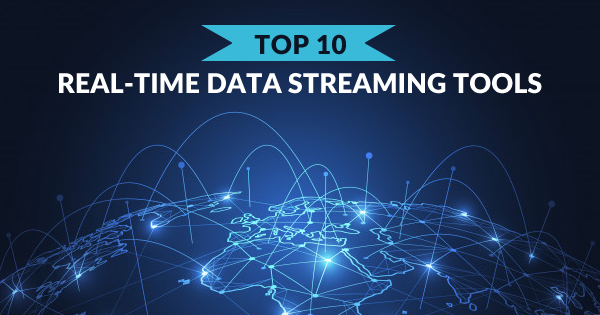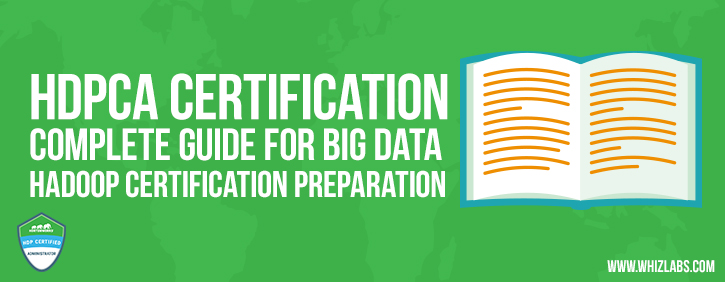Real-time data streaming has become prominent in the field of big data analytics, and so real-time data streaming tools. Let’s dive deep and check out the list of top 10 data streaming tools for real-time analytics of data.
The importance of data is not something any enterprises would compromise with. Therefore, the demand for data analytics is increasing substantially. Almost 90% of the total data available now has been created in the mere gap of one year between 2017 and 2018. Therefore, the popularity of real-time data streaming tools is increasing among enterprises worldwide.
bData streaming is one of the notable interventions in the field of data analytics and machine learning. The importance of data streaming is evident in the support it provides to enterprises through quick decision-making capabilities. Enterprises are shifting to the cloud computing landscape in large numbers, and data streaming tools helps in improving the agility of data pipelines for different applications.
Enroll Now: Apache Kafka Fundaments Training Course
Most Popular Real-Time Data Streaming Tools
Data streaming takes care of distinct business needs. Thorough awareness of the importance of tools used for data streaming can help organizations in the adoption of hybrid platforms. As a result, enterprises could gain maximum benefits from the batch as well as streaming data analytics. The following discussion presents an outline of the top ten real-time data streaming tools, along with their brief descriptions.
1. Google Cloud DataFlow
The first entry among real-time analytics tools is Google Cloud DataFlow. Google recently excluded Python 2 and powered Cloud DataFlow with Python SDK and Python 3 for supporting data streaming. The use of streaming analytics in Google Cloud DataFlow helps in filtering ineffectual data that can slow down the speed of analytics. In addition, users can also utilize Apache Beam with Python for defining data pipelines to ensure extraction, transformation, and analysis of data from different IoT devices and additional data sources.
2. Amazon Kinesis
Amazon Kinesis is also a notable mention among the top real-time data streaming tools which allows streaming Big Data with AWS. Enterprises can develop streaming applications by leveraging open-source Java libraries and SQL editor with Amazon Kinesis. The best thing about Kinesis is that it takes care of the major responsibilities of running applications and scaling them according to requirements.
As a result, enterprises can easily reduce the need for managing servers and other complexities related to the development, integration, and management of applications for real-time analytics.
One of the most crucial traits of Amazon Kinesis that makes it one of the top open-source data streaming tools is flexibility. The flexibility of Kinesis helps enterprises start initially with basic reports and insights on data. Subsequently, with the growth of demand, Kinesis can help in the deployment of machine learning algorithms to support in-depth analysis.
Also Read: Top 10 Open Source Big Data Tools
3. Apache Kafka
Apache Kafka is also a leading mention among real-time data streaming tools. Enterprises can use Apache Kafka for the management of peak data ingestion loads and also as a big data message bus. The capability of Apache Kafka to manage peak data ingestion loads is a unique and formidable advantage over common storage engines.
The general application of Kafka is in the back end for the integration of microservices. In addition, it can also support other real-time data streaming portals such as Flink or Spark. Interestingly, the majority of real-time data streaming platforms can integrate effectively with Kafka to provide stream analytics and stream processing.
Kafka can also send data to other platforms for streaming analytics for the purpose of analysis. Since Kafka is a comparatively new technology than others, users can find it a little bit difficult to operate. However, the features of data redundancy and fault tolerance offered a credible boost to the reputation of Kafka, among other tools used for data streaming.
4. Apache Storm
Apache Storm is the next popular mention among the top open-source data streaming tools. Storm is an ideal tool for real-time data analytics. Built by Twitter, Apache Storm specifically aims at the transformation of data streams. This is a considerable difference from Hadoop which is one of the top Big Data tools, which relies on batch processing.
On the other hand, the applications of Apache Storm are also useful for ETL, online machine learning, and many others. The foremost capability of Apache Stream is faster data processing. Apache Stream can carry out processes at the nodes with faster data processing than its competitors. Most important of all, you can integrate Apache Storm with Hadoop to improve its capability for larger throughputs.
Also Read: Apache Storm vs Apache Spark
5. Azure Stream Analytics
One of the prominent names that frequently arise in discussions on real-time data streaming tools is Azure Stream Analytics. The design of Azure Stream Analytics focuses on the delivery of mission-critical end-to-end analytics services. Interestingly, Azure Stream Analytics provides faster analytics outcomes within a limited time by leveraging C#, SQL, and JavaScript.
The in-built machine learning capabilities of Azure Stream Analytics also provide adequate support for intuitive data processing. The machine learning capabilities also help in easier identification of spikes and dips, slow positive and negative trends, and outliers pertaining to streamed data. As a result, users could easily interpret the output visualizations. Based on these advantages, Azure Stream Analytics establishes its reputation among various popular data streaming tools.
6. StreamSQL
StreamSQL is the unique transformation of SQL for providing a real-time data streaming tool. The effectiveness of StreamSQL as one of the top tools for real-time data processing in big data depends on its simplicity. The simplicity of StreamSQL is suitable even for non-developers. StreamSQL makes it easier for the development of applications to ensure the manipulation of data streams, real-time compliance, surveillance, and monitoring networks.
The foundation of StreamSQL is SQL and is the reason for many advantages that enterprises can get with it. Being built on top of SQL, StreamSQL offers higher speed, better ease of use, and faster responsiveness for analytics. Subsequently, you can also note that StreamSQL takes away the need for inspection of streaming information. As a result, the job of data scientists becomes easier with StreamSQL.
7. Apache NIFI
Apache NIFI is also one of the notable names that come up among tools for real-time data processing in big data. The effective features of Apache NIFI include integrated data logistics features. The integrated data logistics features help in making Apache NIFI the ideal platform for the automation of data movement between different destinations and sources.
In addition, the capabilities of Apache NIFI as one of the best real-time analytics tools include support for distributed sources. Distributed sources can include social feeds, videos, files, log files, and others. Most important of all, it can ensure the movement of data between any source and destination. Furthermore, it also has the capabilities for tracing data in real-time, and its working is quite similar to the functioning of UPS and FedEx delivery services.
Every day we may come across something new in the world of Big Data. Here are the Big Data Predictions stating the new world of data analytics.
8. IBM Stream Analytics
IBM Stream Analytics also deserves better recognition than tools for open source real-time analytics. It provides Eclipse-based IDE (Integrated Development Environment) alongside support for Java, Python, and Scala programming languages. As a result, it makes it easier to develop real-time data analytics applications.
The capabilities of IBM stream analytics are different than other common real-time data streaming tools. It helps in developing in notebooks so that Python users can ensure effortless monitoring, management, and informed decision making. You can use the streaming services of IBM Streaming Analytics on the IBM BlueMix platform for processing the information in data streams.
9. Spark Streaming
Spark Streaming is the next important entry among tools for open source real-time analytics. The stream analytics service has direct integration with the Apache Spark platform and is one of the most popular open-source real-time data streaming tools. One of the previous versions of Spark Streaming executed streaming processing with the help of a micro-batch process.
However, the streaming framework faced certain performance challenges despite the faster execution of batch jobs. So, the Spark open-source community, which is constantly expanding, contributed a reimplementation of Spark Streaming. The reimplementation has been helpful in improving the performance and lowering latency. Spark Streaming supports Java, Python, and Scala programming languages and provides access to different components of Apache Spark. Furthermore, Spark Streaming also provides exceptional support for merging streaming data and historical data.
10. Apache Flink
The final entrant among the top real-time data streaming tools is Apache Flink. You can think of it as a hybrid of Storm and Spark. Even if Spark provides a batch framework, it does not have any support for real-time streaming like Spark Streaming. Flink overcomes such issues by providing frameworks for batch processing.
As a result, Flink can depict lower latency while also exhibiting the data fault tolerance of Spark. The different windows and redundant settings support user configuration. In addition, Flink also implements Apache Beam, which is the contribution of Google to enable real-time processing.
Preparing for a Big Data interview? Go through these most frequently asked Big Data interview questions and get ready to ace the interview.
Bottom Line
So, you can notice that different real-time data streaming tools have different unique applications and advantages. Real-time streaming analytics help in gaining the advantages of real-time KPI visualization and demand sensing. In addition, data streaming improves the scope of outcomes of data analytics by reflecting on deeper insights. Data streaming helps in deriving the maximum value possible from the data available to them.
Subsequently, enterprises can improve operational efficiency alongside efficient and reasonable decision making. In the long term, real-time data streaming would be a staple requirement for enterprises worldwide. The power of data is massive, and tapping into such massive potential is no easy task.
You can choose the ideal data streaming tool that matches your requirements and spell a new phase of operational excellence for your business. Apache Kafka is one of the most-used data streaming tools that allow real-time data streaming. Enroll now into the Apache Kafka Fundamentals Training course and advance your Data Analytics career.
- Top 45 Fresher Java Interview Questions - March 9, 2023
- 25 Free Practice Questions – GCP Certified Professional Cloud Architect - December 3, 2021
- 30 Free Questions – Google Cloud Certified Digital Leader Certification Exam - November 24, 2021
- 4 Types of Google Cloud Support Options for You - November 23, 2021
- APACHE STORM (2.2.0) – A Complete Guide - November 22, 2021
- Data Mining Vs Big Data – Find out the Best Differences - November 18, 2021
- Understanding MapReduce in Hadoop – Know how to get started - November 15, 2021
- What is Data Visualization? - October 22, 2021

